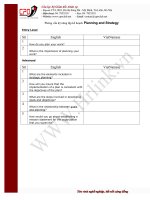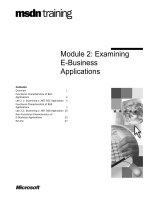Tài liệu Lesson 2: Expressions, Types, and Variables doc
Bạn đang xem bản rút gọn của tài liệu. Xem và tải ngay bản đầy đủ của tài liệu tại đây (57.69 KB, 8 trang )
Using Excellent Tools to Write Web Applications Targeting
the .NET Common Language Runtime (CLR)
[Home] [Up] [Lesson01] [Lesson02] [Lesson03] [Lesson04] [Lesson05
[Lesson06] [Lesson07] [Lesson08] [Lesson09] [Lesson10] [Lesson11
[Lesson12] [Lesson13]
On sale Now! C#
Unleashed is an in-
depth guide for
intermediate to
advanced software
developers to learn
the C#
programming
language and
serve as a desktop
reference.
.
.
.
.
.
.
.
.
.
.
The C# Station Tutorial
by Joe Mayo, 8/27/00, updated 10/6/01
Lesson 2: Expressions, Types, and Variables
This lesson introduces C# expressions, types, and variables. It's goal is to
meet the following objectives:
l
Understand what a "Variable" is.
l
Learn the C# simple types.
l
Obtain a basic understanding of C# expressions.
l
Learn what the String type is.
l
Learn how to use Arrays.
"Variables" are simply storage locations for data. You may place data into
them and retrieve their contents as part of a C# expression. The
interpretation of the data in a variable is controlled through "Types".
C# is a strongly "Typed" language. Thus all operations on variables are
performed with consideration of what the variable's "Type" is. There are
rules that define what operations are legal in order to maintain the
integrity of the data you put in a variable.
The C# simple types consist of the boolean type and three numeric types
integrals, floating point, and decimal.
Listing 1-1. Displaying Boolean Values: Boolean.cs
using System;
class Booleans
{
public static void Main()
{
bool content = true;
bool noContent = false;
Console.WriteLine("It is {0} that C# Station provides C# programming language
Page 1 of 8Tutorial
6/24/2002 />content.", content);
Console.WriteLine("The statement above is not {0}.", noContent);
}
}
In Listing 1-1, the boolean values are written to the console as a part of a
sentence. The "bool" type is simply either a true or false. When run, this
program produces the following output:
>It is True that C# Station provides C# programming language
content.
>The statement above is not False.
The following table shows the integral types, their size, and range.
Integral types are well suited for those operations involving whole number
calculations. The char type is the exception, representing a single
Unicode character. As you can see from the table above, you have a wide
range of options to choose from, depending on your requirements.
The following table shows the floating point and decimal types, their size,
precision, and range.
Floating point types are used when you need to perform operations
requiring fractional representations. However, for financial calculations,
Type Size (in bits) Range
sbyte 8 -128 to 127
byte 8 0 to 255
short 16 -32768 to 32767
ushort 16 0 to 65535
int 32 -2147483648 to 2147483647
uint 32 0 to 4294967295
long 64
-9223372036854775808 to
9223372036854775807
ulong 64 0 to 18446744073709551615
char 16 0 to 65535
Type Size (in bits) Precision Range
float 32 7 digits
1.5 x 10
-45
to 3.4 x 10
38
double 64 15-16 digits
5.0 x 10
-324
to 1.7 x 10
308
decimal 128
28-29 decimal
places
1.0 x 10
-28
to 7.9 x 10
28
Page 2 of 8Tutorial
6/24/2002 />the decimal type may be your best choice.
Results are computed by building expressions. These expressions are built
by combining variables and operators together into statements. The
following table describes the allowable operators, their precedence, and
associativity.
Left associativity means that operations are evaluated from left to right.
Right associativity mean all operations occur from right to left, such as
assignment operators where everything to the right is evaluated before
the result is placed into the variable on the left.
Listing 1-2. Unary Operators: Unary.cs
using System;
class Unary
{
public static void Main()
{
int unary = 0;
int preIncrement;
int preDecrement;
int postIncrement;
int postDecrement;
int positive;
int negative;
Category Operator(s) Associativity
Primary
(x) x.y f(x) a[x] x++ x-- new typeof
sizeof checked unchecked
left
Unary + - ! ~ ++x --x (T)x left
Multiplicative * / % left
Additive + - left
Shift << >> left
Relational < > <= >= is left
Equality == != right
Logical AND & left
Logical XOR ^ left
Logical OR | left
Conditional
AND
&& left
Conditional
OR
|| left
Conditional ?: right
Assignment = *= /= %= += -= <<= >>= &= ^= |= right
Page 3 of 8Tutorial
6/24/2002 /> sbyte bitNot;
bool logNot;
preIncrement = ++unary;
Console.WriteLine("Pre-Increment: {0}", preIncrement);
preDecrement = -- unary;
Console.WriteLine("Pre-Decrement: {0}", preDecrement);
postDecrement = unary-- ;
Console.WriteLine("Post-Decrement: {0}", postDecrement);
postIncrement = unary++;
Console.WriteLine("Post-Increment: {0}", postIncrement);
Console.WriteLine("Final Value of Unary: {0}", unary);
positive = -postIncrement;
Console.WriteLine("Positive: {0}", positive);
negative = +postIncrement;
Console.WriteLine("Negative: {0}", negative);
bitNot = 0;
bitNot = (sbyte)(~bitNot);
Console.WriteLine("Bitwise Not: {0}", bitNot);
logNot = false;
logNot = !logNot;
Console.WriteLine("Logical Not: {0}", logNot);
}
}
When evaluating expressions, post-increment and post-decrement
operators return their current value and then apply the operators.
However, when using pre-increment and pre-decrement operators, the
operator is applied to the variable prior to returning the final value.
In Listing 1-2, the "unary" variable is initialized to zero. When the pre-
increment (++x) operator is used, "unary" is incremented to 1 and the
value 1 is assigned to the "preIncrement" variable. The pre-decrement (--
x) operator turns "unary" back to a 0 and then assigns the value to the
"preDecrement" variable.
When the post-decrement (x--) operator is used, the value of "unary", 0, is
placed into the "postDecrement" variable and then "unary" is decremented
to -1. Next the post increment (x++) operator moves the current value of
"unary", -1, to the "postIncrement" variable and then increments "unary" to
0.
The variable "bitNot" is initialized to zero and the bitwise not operator is
applied. The bitwise not (~) operator flips the bits in the variable. In this
case, the binary representation of 0, "00000000", was transformed into -1,
Page 4 of 8Tutorial
6/24/2002 />"11111111".
Notice the expression "(sbyte)(~bitNot)". Any operation performed on
types sbyte, byte, short, or ushort return integer values. To assign the
result into the bitNot variable we had to use a cast (Type) operator, where
Type is the type you wish to convert to (in this case - sbyte). Cast
operators must be performed explicity when you go from a larger type to a
smaller type because of the potential for lost data. Generally speaking,
assigning a smaller type to a larger type is no problem, since the larger
type has room to hold the entire value. Also be aware of the dangers of
casting between signed and unsigned types. You want to be sure to
preserve the integrity of your data. Many basic programming texts contain
good descriptions of bit representations of variables and the dangers of
explicit casting.
The logical not (!) operator allows you to toggle the value of a boolean
variable. In the example, the "logNot" variable is changed from false to
true. You can expect the following output from the above program.
>Pre-Increment: 1
>Pre-Decrement 0
>Post-Decrement: 0
>Post-Increment -1
>Final Value of Unary: 0
>Positive: 1
>Negative: -1
>Bitwise Not: -1
>Logical Not: True
Listing 1-3. Binary Operators: Binary.cs
using System;
class Binary
{
public static void Main()
{
int x, y, result;
float floatResult;
x = 7;
y = 5;
result = x+y;
Console.WriteLine("x+y: {0}", result);
result = x-y;
Console.WriteLine("x-y: {0}", result);
result = x*y;
Console.WriteLine("x*y: {0}", result);
Page 5 of 8Tutorial
6/24/2002 />









